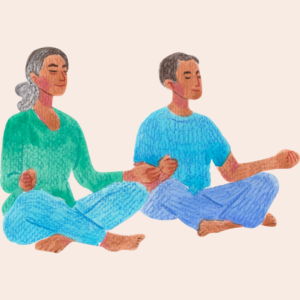Enhancing Relationships through Guided Meditation: A Journey of Empathy, Compassion, and Improved Communication
 In the frenetic pace of our day-to-day lives, we frequently discover that we have become entangled in an overwhelming number of commitments and obligations.
In the frenetic pace of our day-to-day lives, we frequently discover that we have become entangled in an overwhelming number of commitments and obligations.
It’s easy for our relationships, which are the very connections that give our life purpose, to take a back seat among all of this upheaval and disarray. Nevertheless, there is a strong tool that can assist us in cultivating these relationships, and that tool is guided meditation.
A journey toward understanding others, cultivating empathy, and better communication, guided meditation is not simply about finding inner peace for oneself; rather, it is a journey in itself. It comes down to cultivating an environment in which compassion may blossom and healthy connections can develop.
The Benefits of Guided Meditation for Personal and Professional Relationships
The consequences of guided meditation on our interpersonal connections can be substantial. It encourages the growth of empathy in us, which in turn enables us to comprehend and identify with the emotions of other people. It promotes compassion, which in turn increases one’s desire to alleviate the pain of others. It also improves our communication skills, making it easier for us to convey both our thoughts and feelings in a clear and concise manner.
According to the findings of a study that was recently published in the Journal of Marital and Family Therapy, a form of guided meditation known as mindfulness meditation was found to improve the quality of relationships between couples by increasing relationship satisfaction, autonomy, relatedness, and non-reactivity to stressful relationship situations.
Real-Life Examples Guided Meditation
Take for example the tale of Sarah and Mark, a couple who were on the verge of breaking up when we met them. They were stuck in an endless loop of disagreements and misunderstandings with one another. However, after they began engaging in guided meditation, things began to take a turn for the better.
They were able to learn how to listen without passing judgment, how to articulate their feelings without resorting to anger or resentment, and how to be present in the moment by practicing meditation. They started to see things from each other’s points of view, and as a result, they developed a newfound feeling of empathy and compassion for one another. The practice of guided meditation did more than simply save their relationship; it also made it more robust and resistant to strain.
Another illustration is that of a business group that was having trouble with disagreements among its own members. The dynamics of the team saw a big shift for the better once its leader began leading sessions of guided meditation. The members of the team have reported enhanced understanding and empathy for one another, along with improvements in their communication. They were able to work together more successfully as a result of the exercise, which led to an increase in both productivity and satisfaction on the job.
Instructions for Carrying Out Guided Meditation as a Regular Practice
The following is a list of practical measures that can be taken to include guided meditation in your everyday routine:
Choose a Quiet Space: Find a quiet, comfortable space where you won’t be disturbed. This could be a corner of your room, a garden, or even a quiet café.
Establish a Regular Time: The key to successful meditation is maintaining consistency. You should commit to practicing at the same time every day. It could be very early in the morning, while you are eating lunch, or right before you go to bed.
Begin with Short Sessions: If you are new to meditation, it is best, to begin with short sessions lasting between five and ten minutes. As you become more accustomed to the practice, you can progressively extend the amount of time you spend meditating.
Utilize Different Guided Meditation Tools: The internet provides access to a wide variety of guided meditation tools, such as podcasts, YouTube channels, and applications like Headspace and Calm. These materials walk you through the meditation process, making it simpler to get started even if you’ve never done it before.
Pay Attention to Your Breath: As you meditate, pay attention to the way in which you are breathing. Take note of the sensation of air going into and out of your body. In the event that your thoughts wander, return your attention back slowly to your breathing.
Engage in attentive Listening: Make it a habit to engage in attentive listening in all of your everyday encounters. Give the other person your undivided attention, free of criticism and any potential distractions. Your ability to communicate with others may dramatically increase as a result of this.
Incorporate Loving-Kindness Meditation: This loving-kindness meditation is a sort of guided meditation that focuses on cultivating sentiments of compassion and love towards yourself as well as others. It entails repeating statements in one’s head silently, such as “May I be happy. I pray that all is fine with you. Please keep me from harm. The phrase “May I be peaceful and at ease,” which is then extended to others, is becoming increasingly popular.
Conclusion Enhancing Relationships through Guided Meditation
The practice of guided meditation is more of a journey than it is an endpoint. It’s about making a concerted effort every day to comprehend, empathize with, and communicate with others more effectively. It’s about cultivating the relationships we have and turning them into things that bring us joy and satisfaction. Why not start this journey today and witness the difference it makes in the way your relationships develop? You can do this now begin your journey and enhance your relationships through guided meditations.
